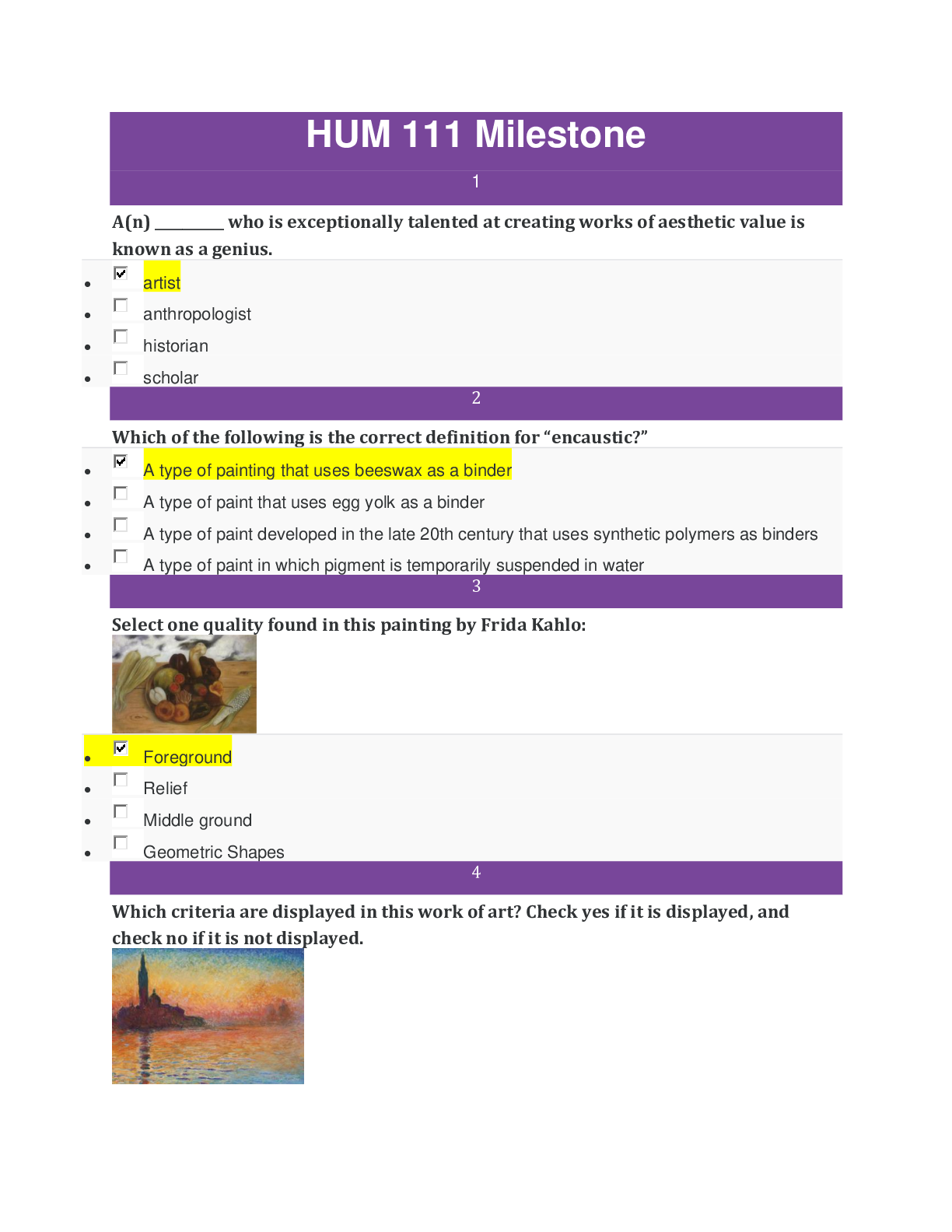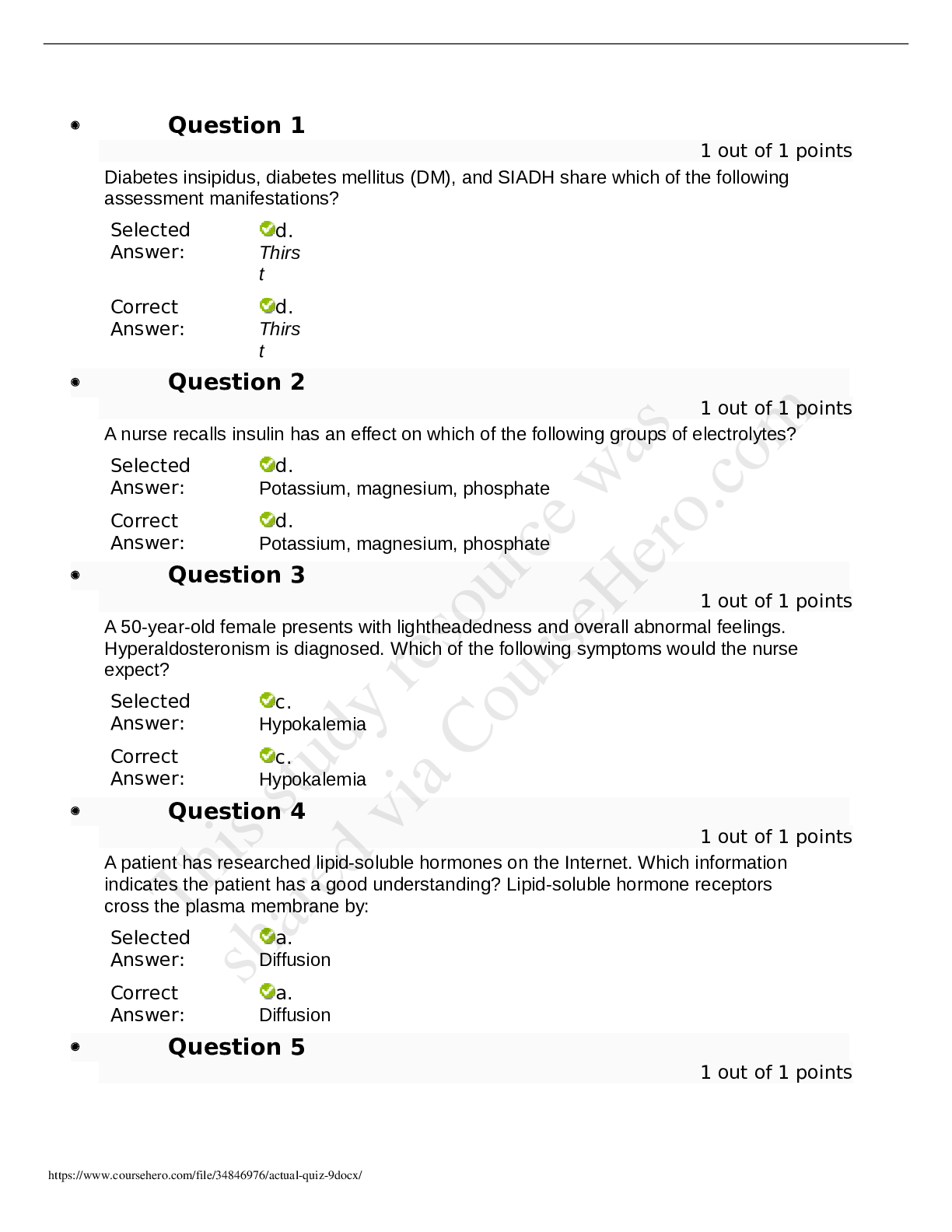*NURSING > QUESTIONS & ANSWERS > POST TEST QUESTIONS AND ANSWERS, 100% ACCURATE, GRADED A+ (All)
POST TEST QUESTIONS AND ANSWERS, 100% ACCURATE, GRADED A+
Document Content and Description Below
1. The primary indication for transferring a patient to a higher level trauma center is: unavailability of a surgeon or operating room staff. multiple system injuries, including severe he... ad injury. resource limitations as determined by the transferring doctor. resource limitations as determined by the hospital administration. widened mediastinum on chest x-ray following blunt thoracic trauma. 2. teen-aged bicycle rider is hit by a truck traveling at a high rate of speed. In the emergency department, she is actively bleeding from open fractures of her legs, and has abrasions on her chest and abdominal wall. Her blood pressure is 80/50 mm Hg, heart rate is 140 beats per minute, respiratory rate is 8 breaths per minute, and GCS score is 6. The first step in managing this patient is to: obtain a lateral cervical spine x-ray. insert a central venous pressure line. administer 2 liters of crystalloid solution. perform endotracheal intubation and ventilation. apply the PASG and inflate the leg compartments. 3. Contraindication to nasogastric intubation is the presence of a: gastric perforation. diaphragmatic rupture. open depressed skull fracture. fracture of the cervical spine. fracture of the cribriform plate. 4. Which one of the following statements regarding patients with thoracic spine injuries is TRUE? Log-rolling may be destabilizing to fractures from T-12 to L-1. Adequate immobilization can be accomplished with the scoop stretcher. Spinal cord injury below T-10 usually spares bowel and bladder function. Hyperflexion fractures in the upper thoracic spine are inherently unstable. These patients rarely present with spinal shock in association with cord injury. 5. young man sustains a ritle wound to the midabdomen. He is brought promptly to the emergency department by prehospital personnel. His skin is cool and diaphoretic, and his systolic blood pressure is 58 rnm Hg. Warmed crystalloid fluids are initiated without improvement in his vital signs. The next, most appropriate step is to perform: a celiotomy. an abdominal CT scan. diagnostic laparoscopy. abdominal ultrasonography. a diagnostic peritoneal lavage. 6. young woman sustains a severe head injury as the result of a motor vehicular crash. In the emergency department, her GCS score is 6. Her blood pressure is 140/90 mm Hg and her heart rate is 80 beats per minute. She is intubated and is being mechanically ventilated. Her pupils are 3 mm in size and equally reactive to light. There is no other apparent injury. The most important principle to follow in the early management of her head injury is to: administer an osmotic diuretic. prevent secondary brain injury. aggressively treat systemic hypertension. reduce metabolic requirements of the brain. distinguish between intracranial hematoma and cerebral edema. 7. 22-year-old man is brought to the hospital after crashing his motorcycle into a telephone pole. He is unconscious and in profound shock. He has no open wounds or obvious fractures. The cause of his shock is MOST LIKELY caused by: a subdural hematoma. an epidural hematoma. a transected lumbar spinal cord. a transected cervical spinal cord. hemorrhage into the chest or abdomen. 8. 30-year-old man is struck by a car traveling at 56 kph (35 mph). He has obvious fractures of the left tibia near the knee, pain in the pelvic area, and severe dyspnea. His heart rate is 180 beats per minute, and his respiratory rate is 48 breaths per minute with no breath sounds heard in the left chest. A tension pneumothorax is relieved by immediate needle decompression and tube thoracostomy. Subsequently, his heart rate decreases to 140 beats per minute, his respiratory rate decreases to 36 breaths per minute, and his blood pressure is 80/50 inm Hg. Warmed Ringer's lactate is administered intravenously. The next priority should be to: perform a urethrogram and cystogram. perform external fixation of the pelvis. obtain abdominal and pelvic CT scans. perform arterial embolization of the pelvic vessels. perform diagnostic peritoneal lavage or abdominal ultrasound. 9. 8-year-old girl is an unrestrained passenger in a vehicle struck from behind. In the emergency department, her blood pressure is 80/60 mm Hg, heart rate is 80 beats per minute, and respiratory rate is 16 breaths per minute. Her GCS score is 14. She complains that her legs feel "funny and won't move right;" however, her spine x-rays do not show a fracture or dislocation. A spinal cord injury in this child: is most likely a central cord syndrome. must be diagnosed by magnetic resonance imaging. can be excluded by obtaining a CT of the entire spine. may exist in the absence of objective findings on x-ray studies. is unlikely because of the incomplete calcification of the vertebral bodies. 10. Immediate chest tube insertion is indicated for which of the following conditions? Pneumothorax Pneumomediastinum Massive hemothorax Diaphragmatic rupture Subcutaneous emphysema 11. 18-year-old, helmeted motorcyclist is brought by ambulance to the emergency department following a high-speed crash. Prehospital persormel report that he was thrown 15 meters (50 feet) off his bfice. He has a history of hypotension prior to arrival in the emergency department, but is now awake, alert, and conversational. Which of the following statements is TRUE? Cerebral perfiision is intacto Intravascular volume status is normal. The patient has sensitive vasomotor reflexes.Intraabdominal visceral injuries are unlikely. The patient probably has an acute epidural hematoma. 12. crosstable, lateral x-ray of the cervical spine: must precede endotracheal intubation. excludes serious cervical spine injury. is an essential part of the primary survey. is not necessary for unconscious patients with penetrating cervical injuries. is unacceptable unless 7 cervical vertebrae and the C-7 to T-1 relationship are visualized. 13. During resuscitation, which one of the following is the most reliable as a guide to volume replacement? Pulse rate Hematocrit Blood pressure Urinary output Jugular venous pressure 14. Which one of the following is the recommended method for initially treating frostbite? Vasodilators Anticoagulants Warm (40°C) water Padding and elevation Topical application of silvasulphadiazine 15. young man sustains a gunshot wound to the abdomen and is brought promptly to the emergency department by prehospital personnel. His skin is cool and diaphoretic, and he is confused. His pulse is thready and his femoral pulse is only weakly palpable. The defmitive treatment in managing this patient is to: administer 0-negative blood. apply extemal warming devices. control internal hemorrhage operatively. apply the pneumatic antishock garment. infuse large volumes of intravenous crystalloid solution. 16. To establish a diagnosis of shock: systolic blood pressure must be below 90 mm Hg. the presence of a closed head injury should be excluded. acidosis should be present by arterial blood \gas analysis. the patient must fail to respond to intravenous fluid infu.sion. clinical evidence of inadequate organ perfusion must be present. 17. Absence of breath sounds and dullness to percussion over the left hemithorax are fmdings best explained by: left hemothorax. cardiac contusion. left simple pneumothorax. left diaphragmatic rupture. right tension pneumothorax. 18. 17-year-old helmeted motorcyclist is struck broadside by an automobile at an intersection. He is unconscious at the scene with a blood pressure of 140/90 mm Hg, heart rate of 90 beats per minute, and respiratory rate of 22 breaths per minute. His respirations are sonorous and deep. His GCS score is 6. Immobilization of the entire patient may include the use of all the following EXCEPT: air splints. bolstering devices. a long spine board. a scoop-style stretcher. a semirigid cervical collar. 19. During an altercation, a 32-year-old man sustains a gunshot wound to the right upper hemithorax, above the nipple line with an exit wound posteriorly above the scapula on the right. He is transported by ambulance to a community hospital. He is endotracheally intubated, closed tube thoracostomy is performed, and 2 liters of Ringer's lactate solution are infused through 2 large-caliber IVs. His blood pressure now is 60/0 mm Hg, heart rate is 160 beats per minute, and respiratory rate is 14 breaths per minute (ventilated with 100% 02). The most appropriate next step in managing this patient is: celiotomy. diagnostic peritoneal lavage. arterial blood gas determination. administer packed red blood cells. chest x-ray to confinn tube placement. 20. Which of the following statements regarding iWhich of the following statements regardingnjury to the central nervous system in children is TRUE? Children suffer spinal cord injury without x-ray abnormality more commonly than adults. An infant with a traumatic brain injury may become hypotensive from cerebral edema. Initial therapy for the child with traumatic brain injury includes the administration of methylprednisolone intravenously. Children have more focal mass lesions as a result of traumatic brain injury when compared to adults . Young children are less tolerant of expanding intracranial mass lesions than adults. 21. 5-year-old boy is struck by an automobile and brought to the emergency department. He is lethargic, but withdraws purposefully from painful stimuli. His blood pressure is 90 mm Hg systolic, heart rate is 140 beats per minute, and his respiratory rate is 36 breaths per minute. The preferred route of venous access in this patient is: percutaneous femoral vein cannulation cutdown on the saphenous vein at the ankle. intraosseous catheter placement in the proximal tibia. percutaneous peripheral veins in the upper extremities. central venous access via the subclavian or interna1 jugular vein. [Show More]
Last updated: 2 years ago
Preview 1 out of 18 pages

Buy this document to get the full access instantly
Instant Download Access after purchase
Buy NowInstant download
We Accept:

Reviews( 0 )
$8.00
Can't find what you want? Try our AI powered Search
Document information
Connected school, study & course
About the document
Uploaded On
Aug 24, 2022
Number of pages
18
Written in
Seller

Reviews Received
Additional information
This document has been written for:
Uploaded
Aug 24, 2022
Downloads
0
Views
122











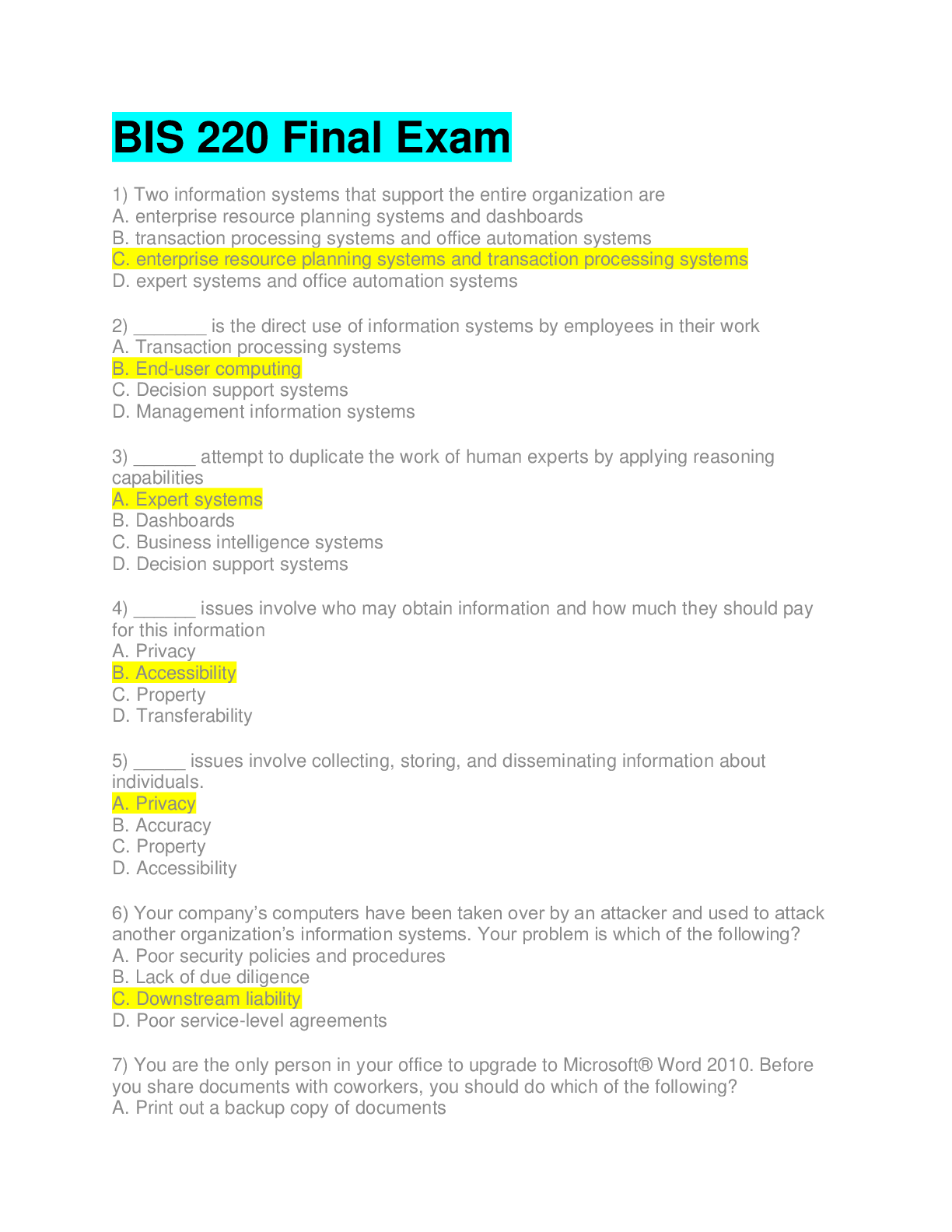
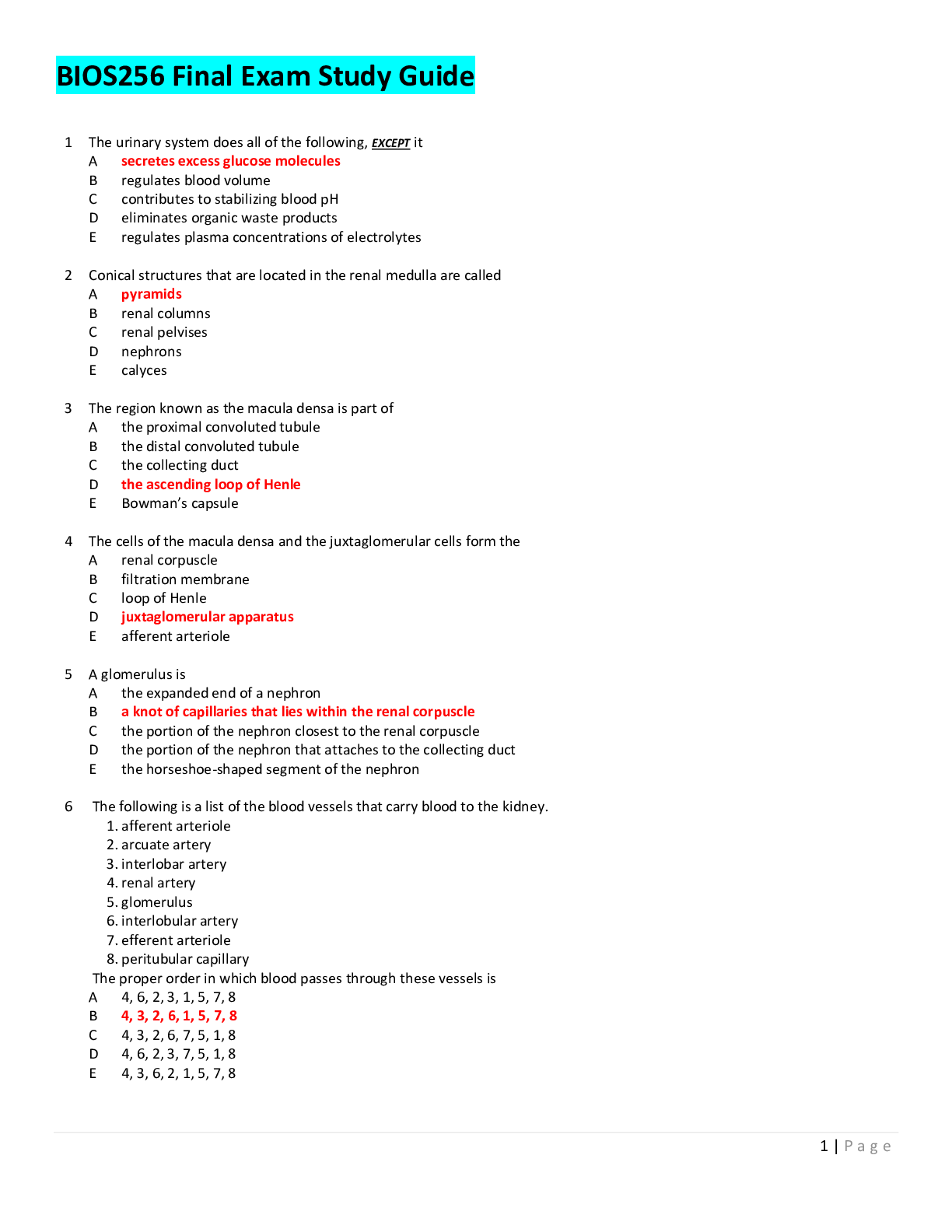
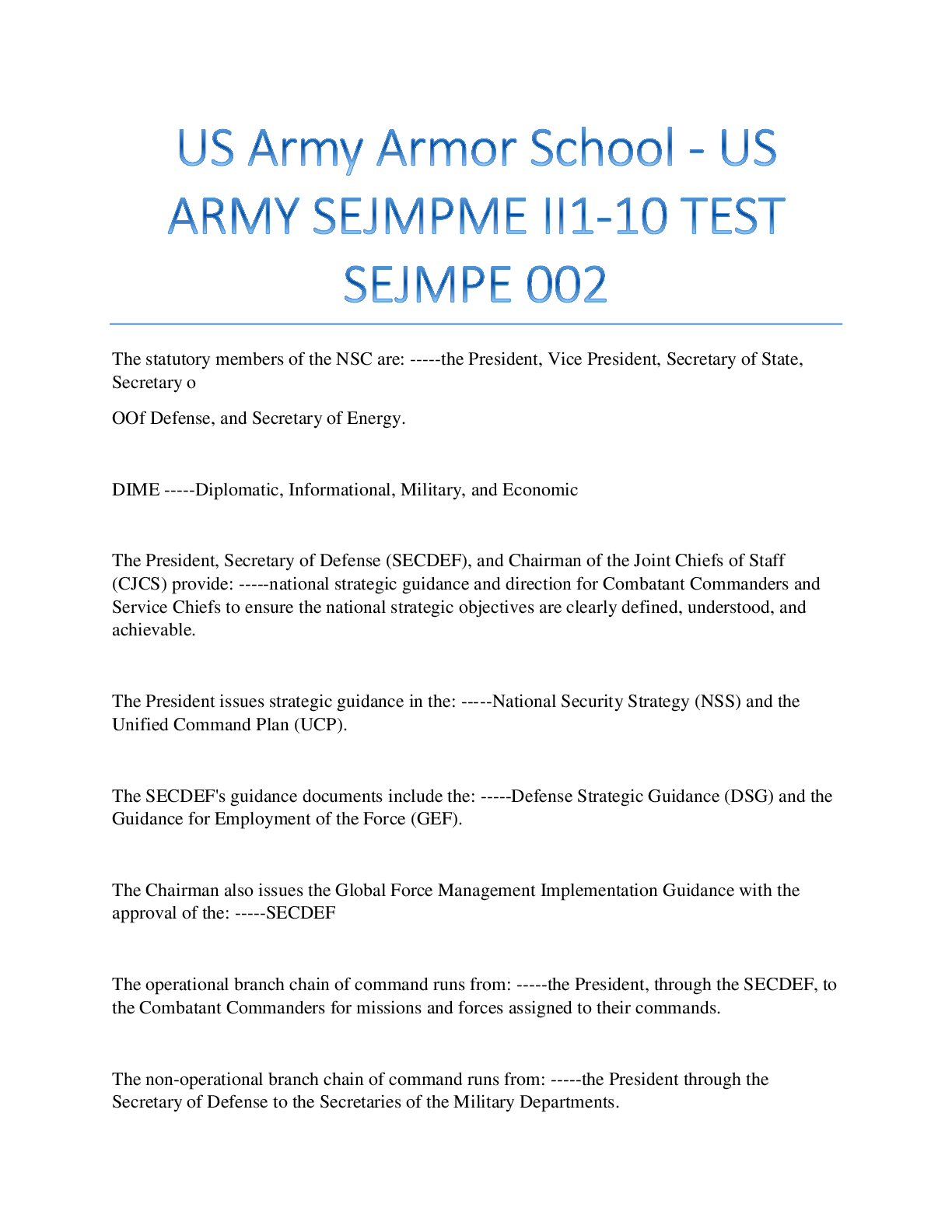

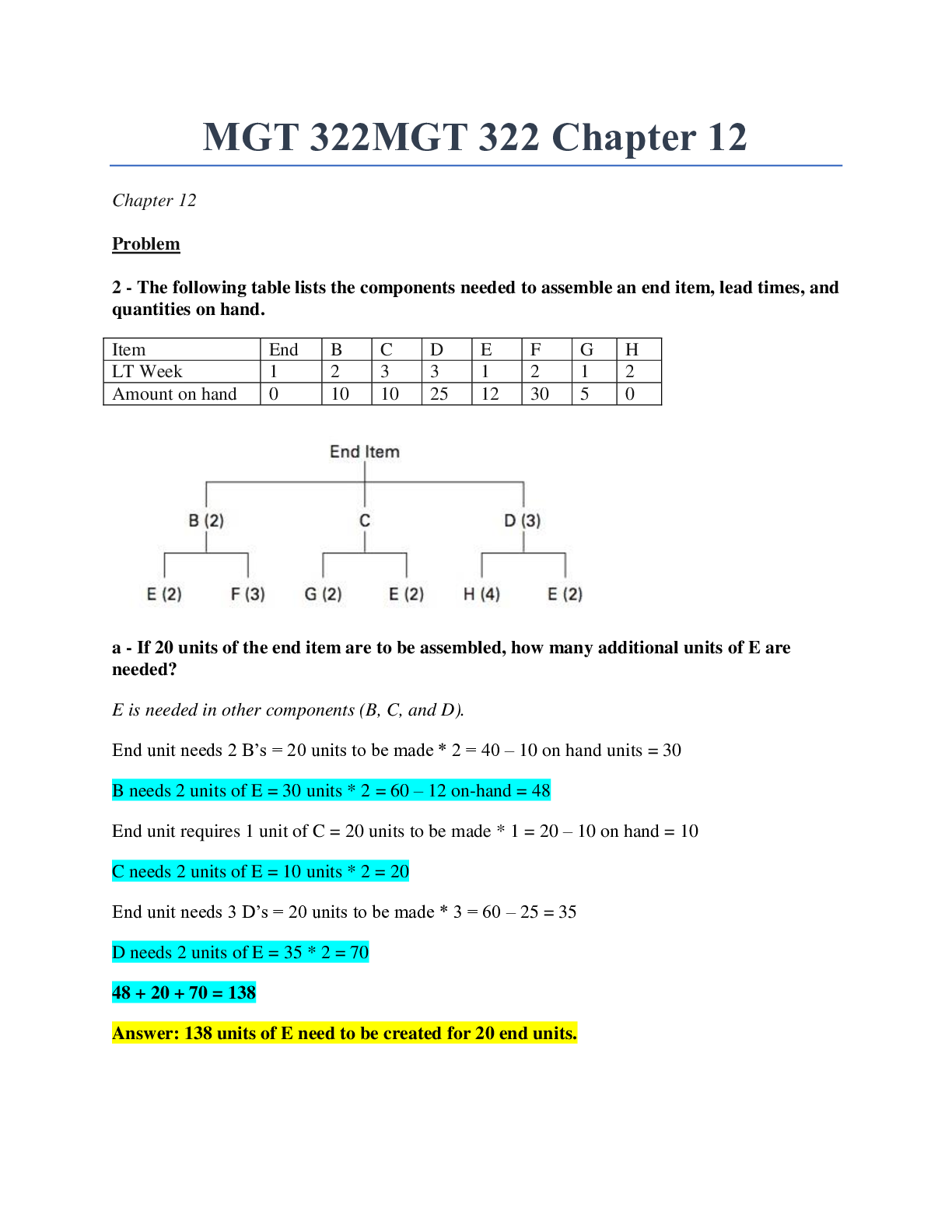
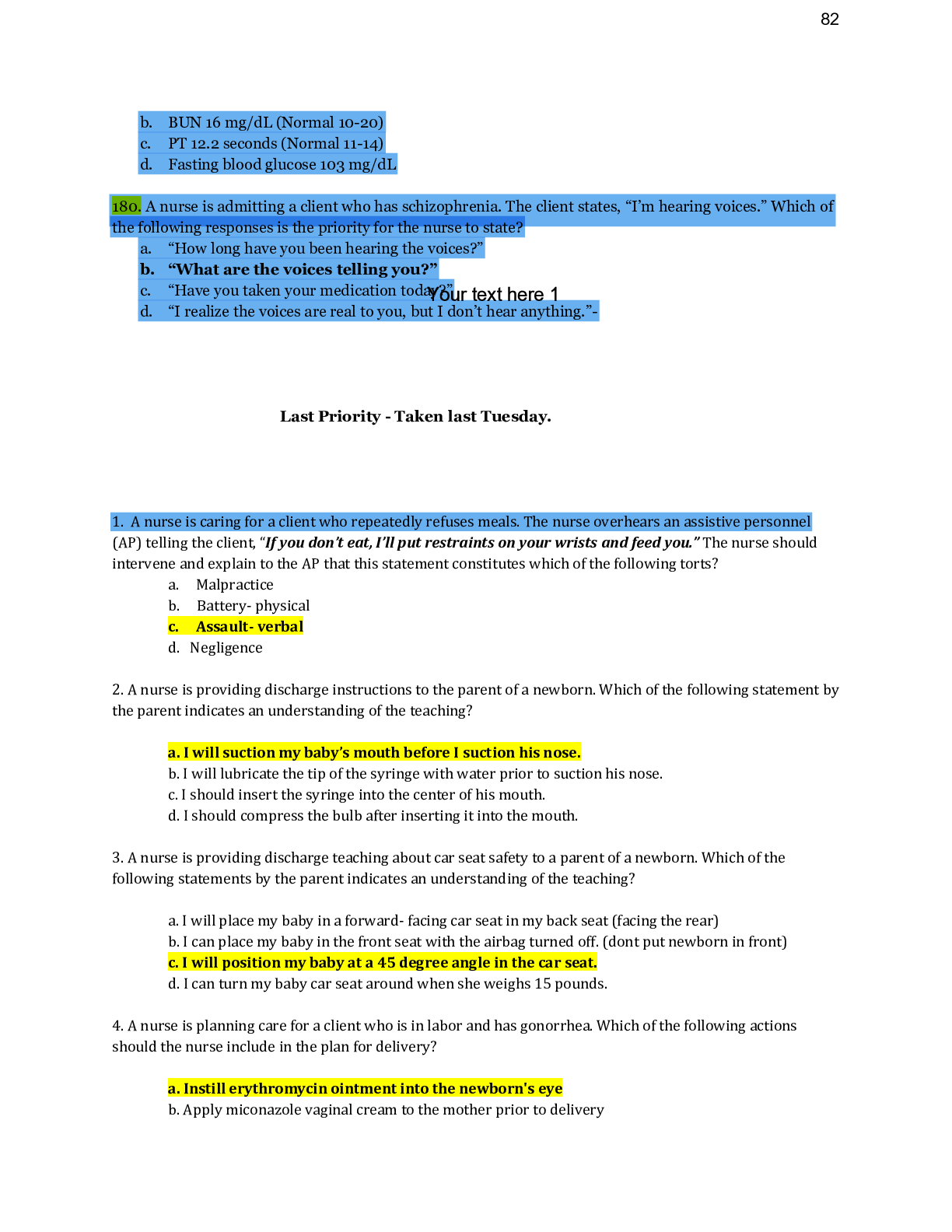
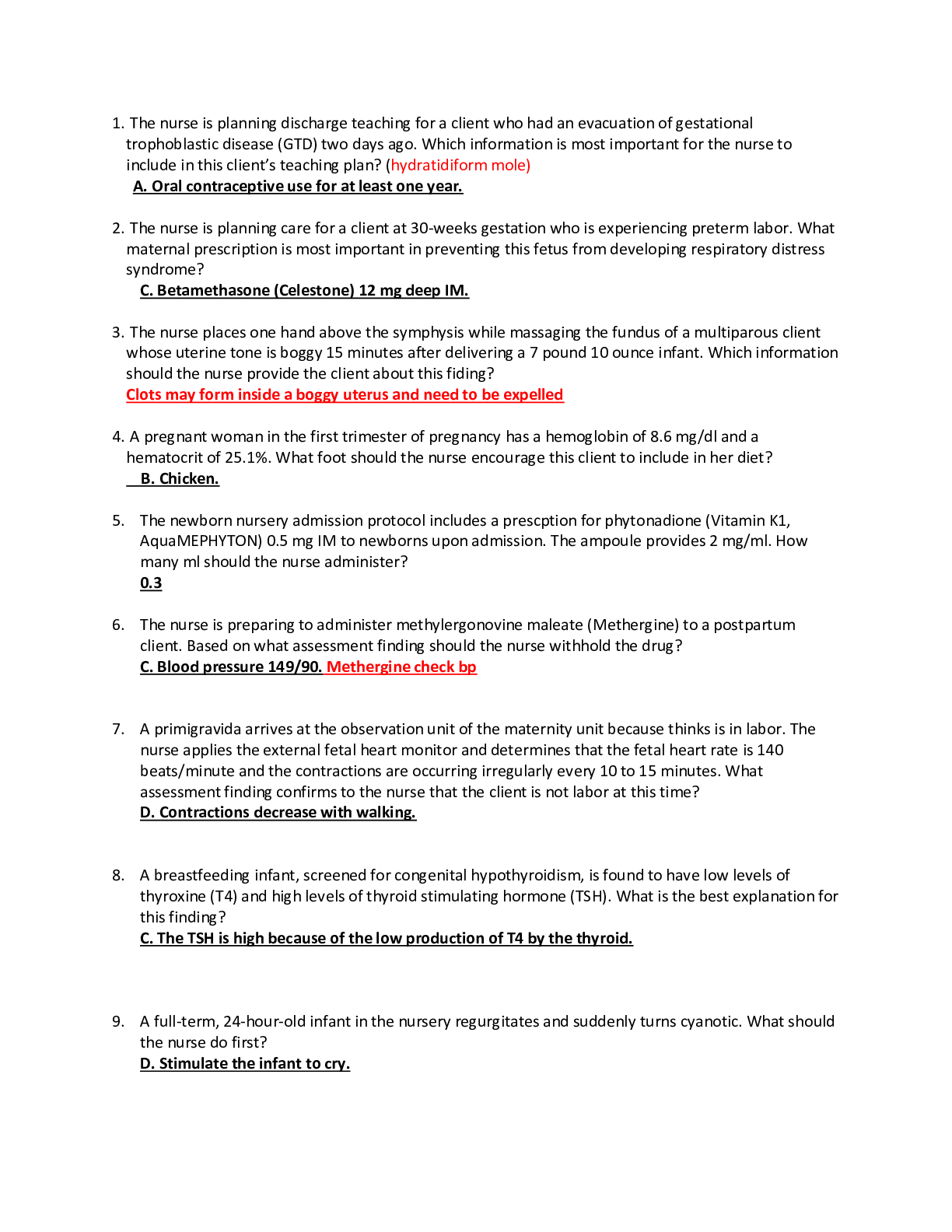
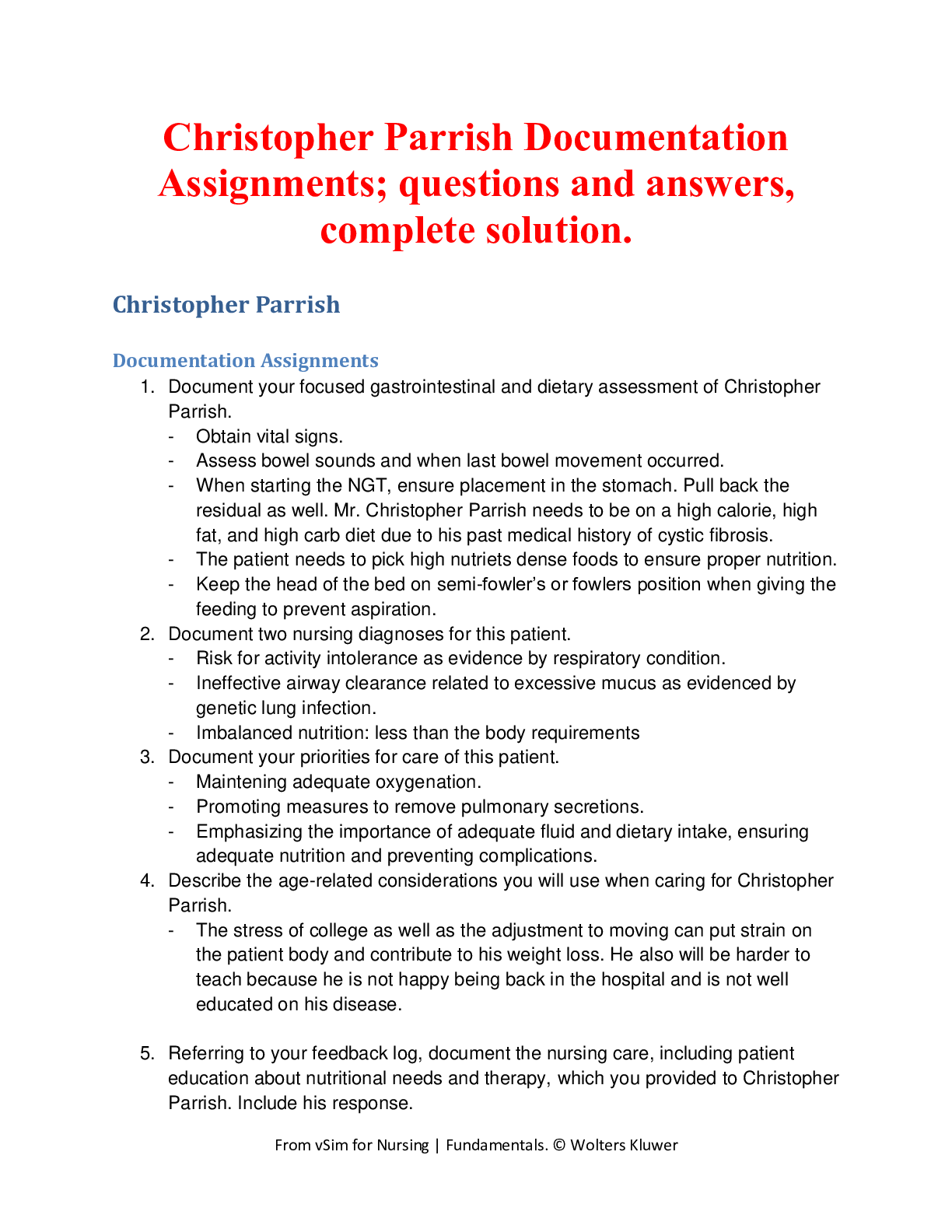
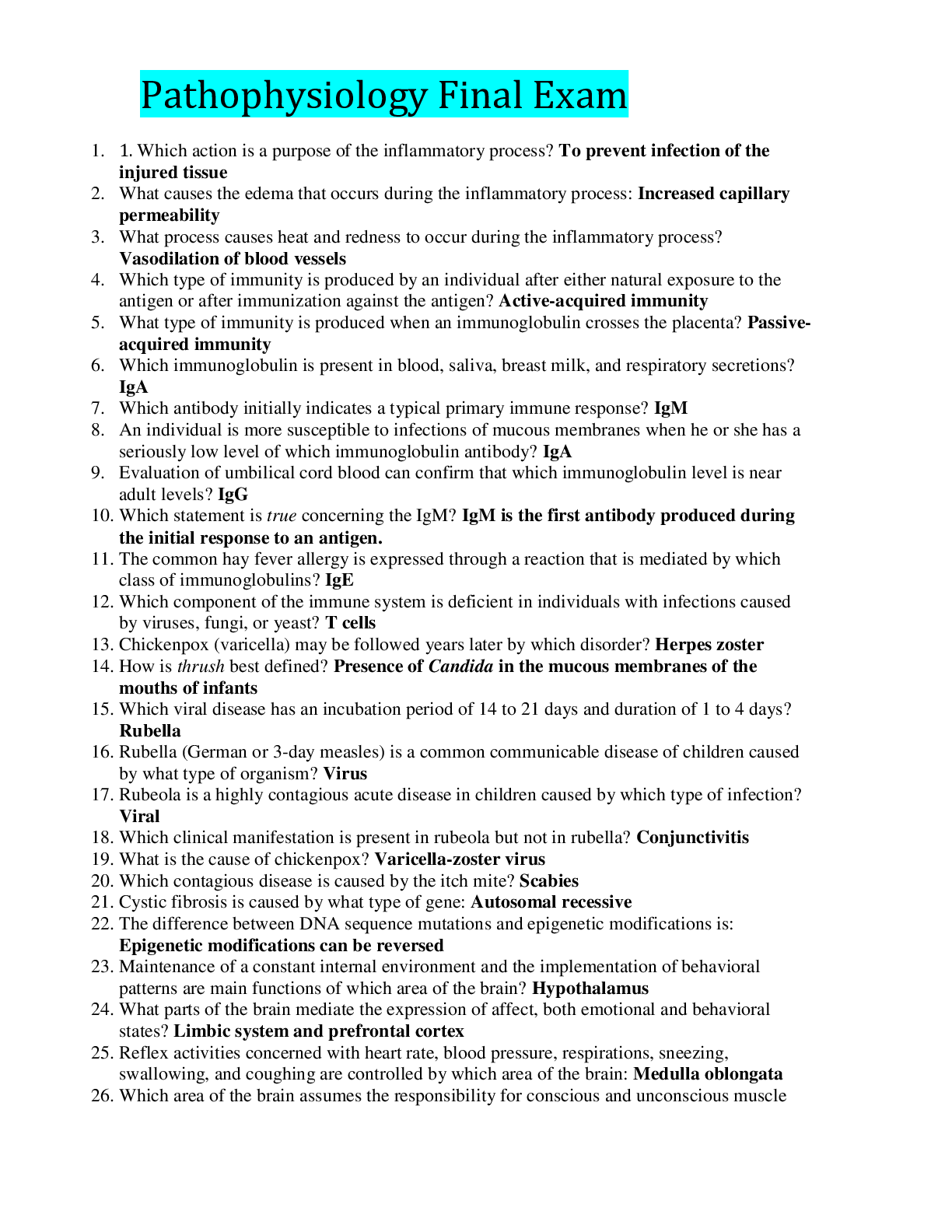
.png)
